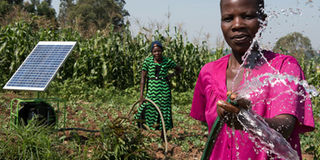Why farmers need drip irrigation for higher profits

Farmer sprays water from a Futurepump solar irrigation pump. Courtesy photo
What you need to know:
- Drip irrigation can last up to 10 years under proper management, cutting down on cost of production and enabling a farmer to earn more profits, writes Japhet Ruto
With irrigation bringing more arable land under cultivation, saving the amount of water in the process is a target for every farmer who wants to spend less and earn more.
Drip irrigation, which allows for consistent releases of water to target plants, is one of the methods gaining popularity for saving up to 50 per cent of this scarce resource.
Wycliffe Obwoge, an agronomist, says the saved water can be used in another round or on similar irrigation field.
At the same time the method allows for application of liquid fertilisers and other farm chemicals like pesticides in a more precise and economic way, he says.
This reduces wastage of pesticides, water, fertiliser and other resources in a greenhouse or open field.
Reduced disease
Overhead irrigation methods encourage accumulation of moisture in the environment. Moisture creates good microclimate for disease causing germs like fungi to thrive.
But drip irrigation will limit water supply to the stem base and it will go direct to the soil.
At the same time, drip irrigation gives farmers more latitude to control water supply. If there are no plants at given outlets, the farmer can temporarily close those holes with a cello tape, allowing for the water to flow to other areas instead of going to waste.
Uniform yield
Consistent amount and rate of water and any other resources included leads to equal supply of nutrients.
For this reason, the crop growth rated and final yield is uniform.
Initial setting up of the pipes may take more labour but later application will be easy, because a farmer will only require turning on the water tank tap. No movement of sprinklers or watering cans through the farm.
Minimal weeds
Localised release of water also reduces growth of weeds.
Crops will also grow faster than weeds because they have sufficient water and nutrients for growth unlike weeds.
Several agrovet shops in major towns supply greenhouses together with the drip irrigation. They also distribute the drip irrigation equipment for open field.
Choose the drip type
Drip irrigation is renowned for being a very efficient method of watering plants. By way of example, the average sprinkler system has an efficiency of around 75-85 per cent. Drip irrigation, in contrast, has efficiencies in excess of 90 per cent. Over time this difference in water delivery efficiency will make a considerable difference in crop production and the company’s bottom line.
In areas where water is in short supply, drip irrigation has, unsurprisingly, become the preferred method of irrigation. Drip irrigation systems are relatively inexpensive and easy to install.




